BMP4005 - Big Data Analysis: Characteristics, Challenges, and Support
VerifiedAdded on 2023/06/17
|8
|2367
|408
Report
AI Summary
This report provides a detailed analysis of big data, including its key characteristics (volume, variety, velocity, value, and veracity), the challenges associated with big data analytics (lack of professional knowledge, improper tool selection, and data security), and the techniques currently available for analyzing big data (A/B testing, data mining, machine learning, and blockchain). It also explores how big data technology can support business by providing competitive advantages, aiding in decision-making, understanding clients, and developing products. The report concludes that managing and controlling big data requires skilled professionals and a thorough understanding of its applications to gain long-term benefits for the organization.
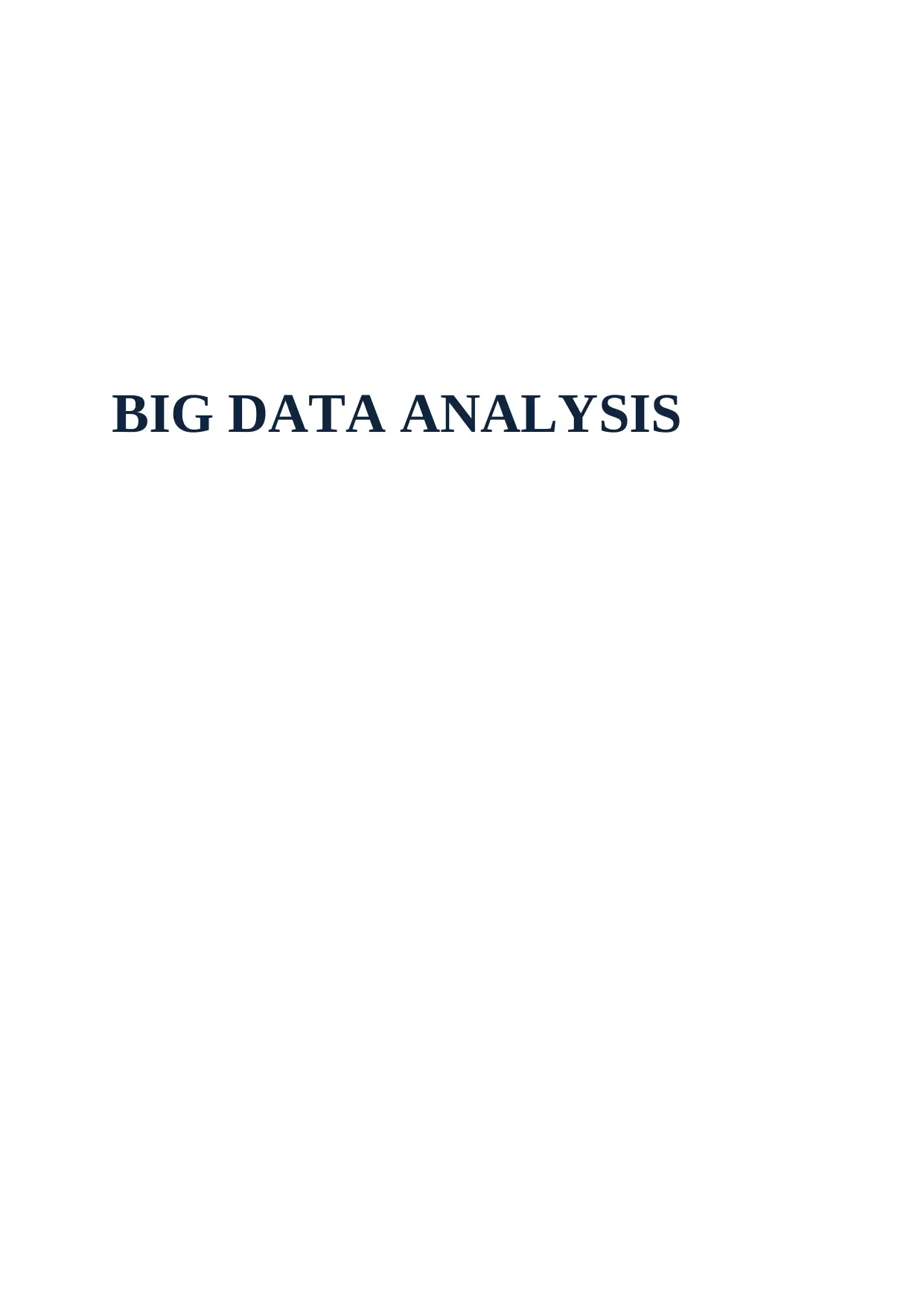
BIG DATA ANALYSIS
Paraphrase This Document
Need a fresh take? Get an instant paraphrase of this document with our AI Paraphraser
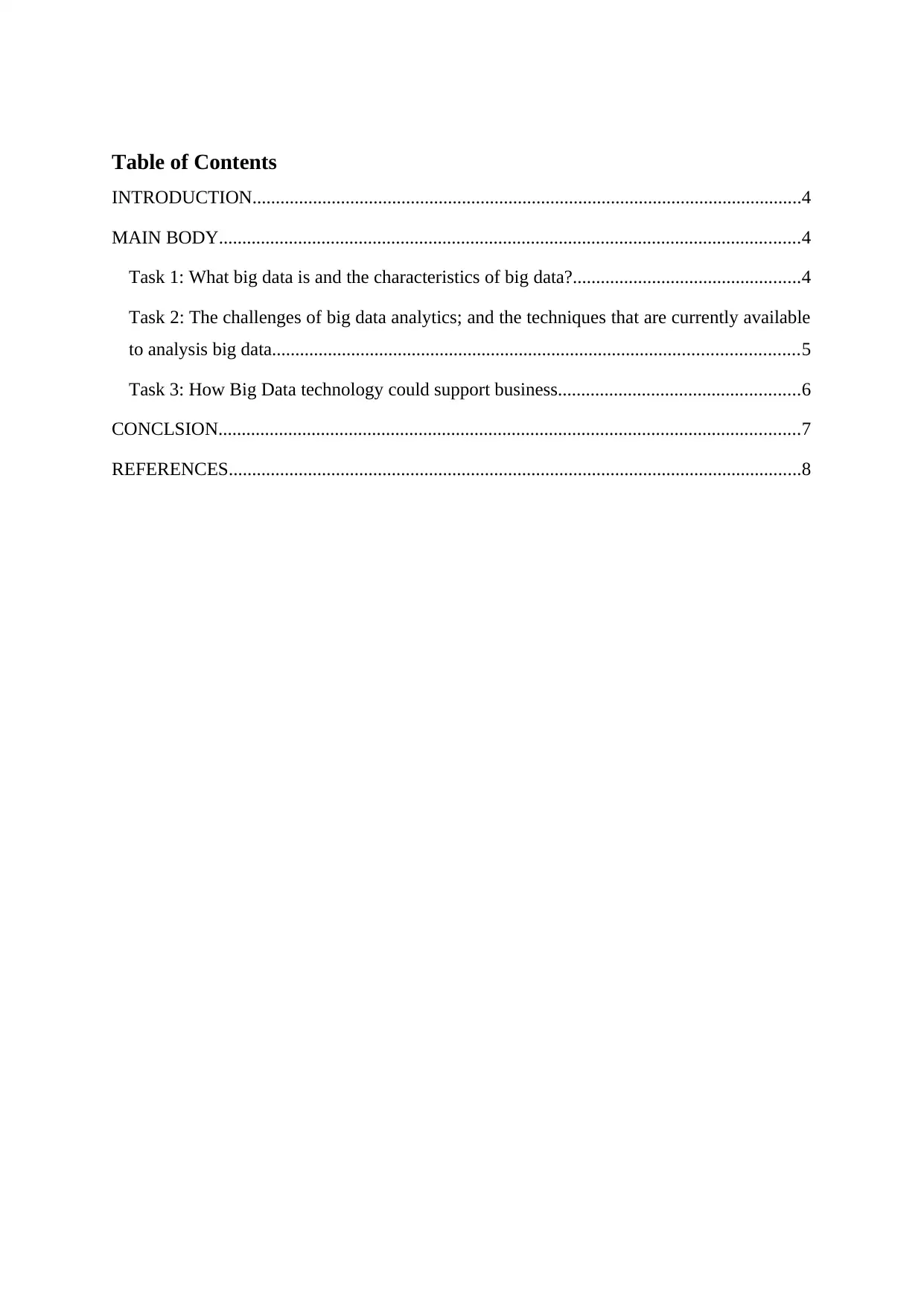
Table of Contents
INTRODUCTION......................................................................................................................4
MAIN BODY.............................................................................................................................4
Task 1: What big data is and the characteristics of big data?.................................................4
Task 2: The challenges of big data analytics; and the techniques that are currently available
to analysis big data.................................................................................................................5
Task 3: How Big Data technology could support business....................................................6
CONCLSION.............................................................................................................................7
REFERENCES...........................................................................................................................8
INTRODUCTION......................................................................................................................4
MAIN BODY.............................................................................................................................4
Task 1: What big data is and the characteristics of big data?.................................................4
Task 2: The challenges of big data analytics; and the techniques that are currently available
to analysis big data.................................................................................................................5
Task 3: How Big Data technology could support business....................................................6
CONCLSION.............................................................................................................................7
REFERENCES...........................................................................................................................8
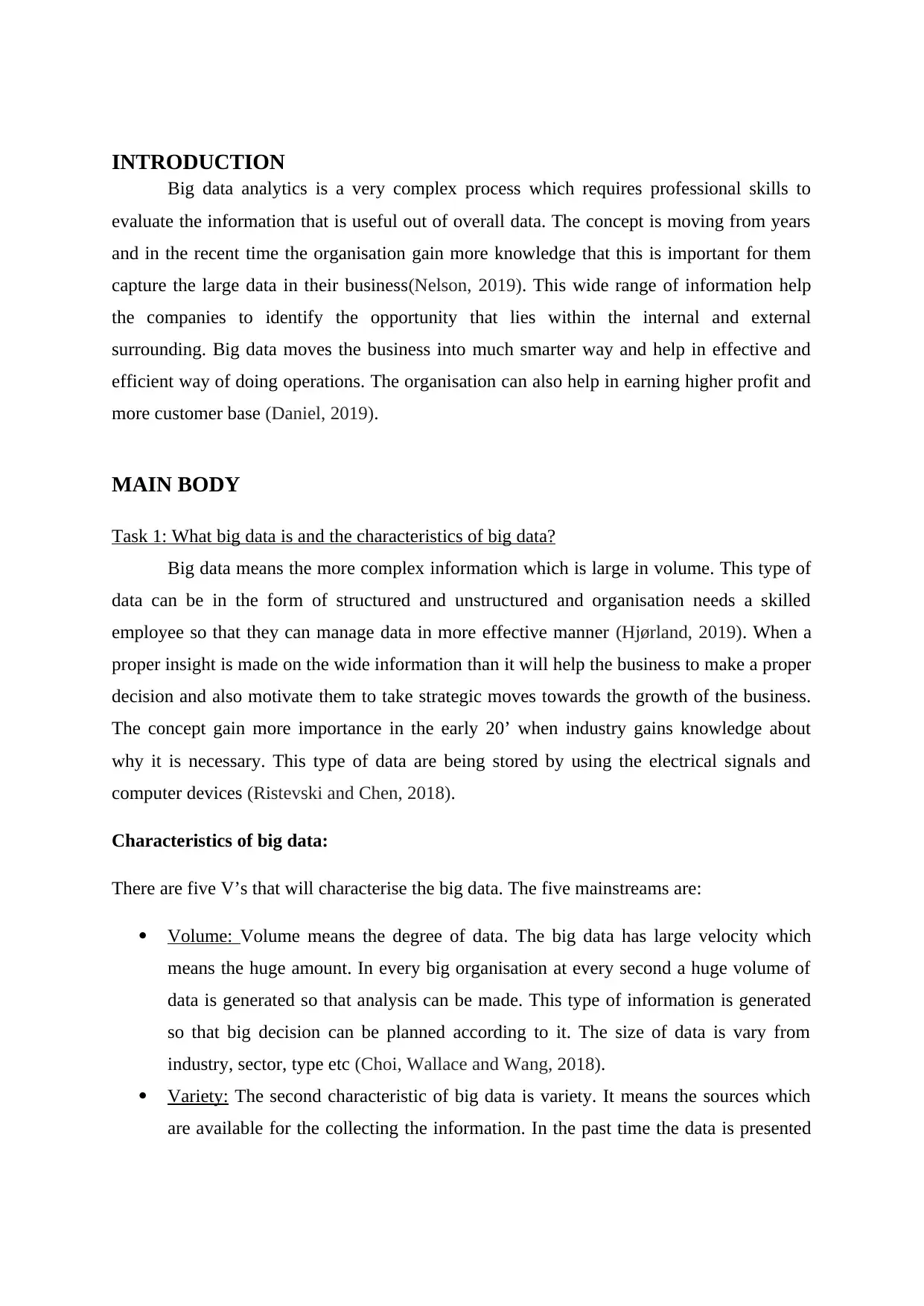
INTRODUCTION
Big data analytics is a very complex process which requires professional skills to
evaluate the information that is useful out of overall data. The concept is moving from years
and in the recent time the organisation gain more knowledge that this is important for them
capture the large data in their business(Nelson, 2019). This wide range of information help
the companies to identify the opportunity that lies within the internal and external
surrounding. Big data moves the business into much smarter way and help in effective and
efficient way of doing operations. The organisation can also help in earning higher profit and
more customer base (Daniel, 2019).
MAIN BODY
Task 1: What big data is and the characteristics of big data?
Big data means the more complex information which is large in volume. This type of
data can be in the form of structured and unstructured and organisation needs a skilled
employee so that they can manage data in more effective manner (Hjørland, 2019). When a
proper insight is made on the wide information than it will help the business to make a proper
decision and also motivate them to take strategic moves towards the growth of the business.
The concept gain more importance in the early 20’ when industry gains knowledge about
why it is necessary. This type of data are being stored by using the electrical signals and
computer devices (Ristevski and Chen, 2018).
Characteristics of big data:
There are five V’s that will characterise the big data. The five mainstreams are:
Volume: Volume means the degree of data. The big data has large velocity which
means the huge amount. In every big organisation at every second a huge volume of
data is generated so that analysis can be made. This type of information is generated
so that big decision can be planned according to it. The size of data is vary from
industry, sector, type etc (Choi, Wallace and Wang, 2018).
Variety: The second characteristic of big data is variety. It means the sources which
are available for the collecting the information. In the past time the data is presented
Big data analytics is a very complex process which requires professional skills to
evaluate the information that is useful out of overall data. The concept is moving from years
and in the recent time the organisation gain more knowledge that this is important for them
capture the large data in their business(Nelson, 2019). This wide range of information help
the companies to identify the opportunity that lies within the internal and external
surrounding. Big data moves the business into much smarter way and help in effective and
efficient way of doing operations. The organisation can also help in earning higher profit and
more customer base (Daniel, 2019).
MAIN BODY
Task 1: What big data is and the characteristics of big data?
Big data means the more complex information which is large in volume. This type of
data can be in the form of structured and unstructured and organisation needs a skilled
employee so that they can manage data in more effective manner (Hjørland, 2019). When a
proper insight is made on the wide information than it will help the business to make a proper
decision and also motivate them to take strategic moves towards the growth of the business.
The concept gain more importance in the early 20’ when industry gains knowledge about
why it is necessary. This type of data are being stored by using the electrical signals and
computer devices (Ristevski and Chen, 2018).
Characteristics of big data:
There are five V’s that will characterise the big data. The five mainstreams are:
Volume: Volume means the degree of data. The big data has large velocity which
means the huge amount. In every big organisation at every second a huge volume of
data is generated so that analysis can be made. This type of information is generated
so that big decision can be planned according to it. The size of data is vary from
industry, sector, type etc (Choi, Wallace and Wang, 2018).
Variety: The second characteristic of big data is variety. It means the sources which
are available for the collecting the information. In the past time the data is presented
⊘ This is a preview!⊘
Do you want full access?
Subscribe today to unlock all pages.

Trusted by 1+ million students worldwide
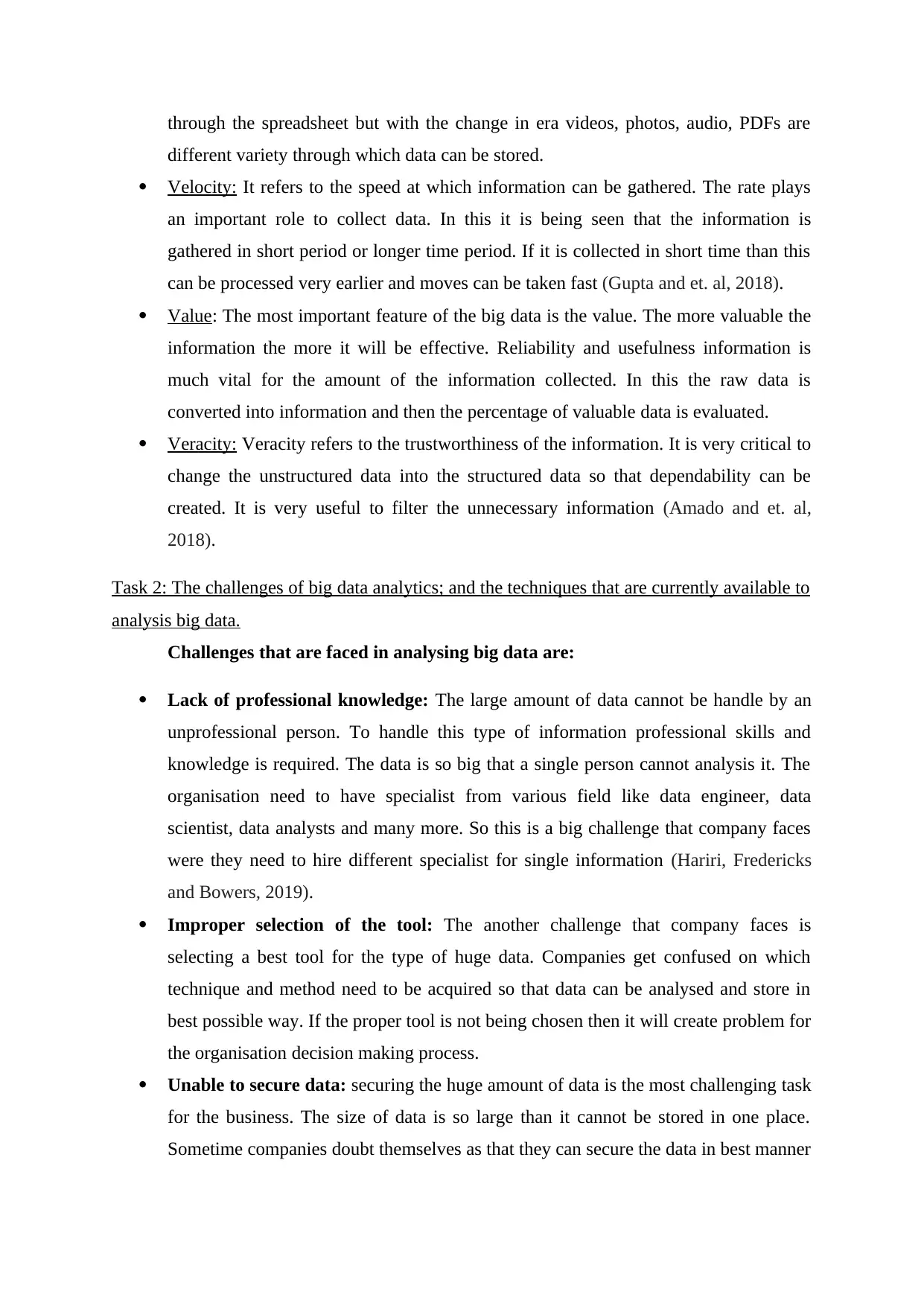
through the spreadsheet but with the change in era videos, photos, audio, PDFs are
different variety through which data can be stored.
Velocity: It refers to the speed at which information can be gathered. The rate plays
an important role to collect data. In this it is being seen that the information is
gathered in short period or longer time period. If it is collected in short time than this
can be processed very earlier and moves can be taken fast (Gupta and et. al, 2018).
Value: The most important feature of the big data is the value. The more valuable the
information the more it will be effective. Reliability and usefulness information is
much vital for the amount of the information collected. In this the raw data is
converted into information and then the percentage of valuable data is evaluated.
Veracity: Veracity refers to the trustworthiness of the information. It is very critical to
change the unstructured data into the structured data so that dependability can be
created. It is very useful to filter the unnecessary information (Amado and et. al,
2018).
Task 2: The challenges of big data analytics; and the techniques that are currently available to
analysis big data.
Challenges that are faced in analysing big data are:
Lack of professional knowledge: The large amount of data cannot be handle by an
unprofessional person. To handle this type of information professional skills and
knowledge is required. The data is so big that a single person cannot analysis it. The
organisation need to have specialist from various field like data engineer, data
scientist, data analysts and many more. So this is a big challenge that company faces
were they need to hire different specialist for single information (Hariri, Fredericks
and Bowers, 2019).
Improper selection of the tool: The another challenge that company faces is
selecting a best tool for the type of huge data. Companies get confused on which
technique and method need to be acquired so that data can be analysed and store in
best possible way. If the proper tool is not being chosen then it will create problem for
the organisation decision making process.
Unable to secure data: securing the huge amount of data is the most challenging task
for the business. The size of data is so large than it cannot be stored in one place.
Sometime companies doubt themselves as that they can secure the data in best manner
different variety through which data can be stored.
Velocity: It refers to the speed at which information can be gathered. The rate plays
an important role to collect data. In this it is being seen that the information is
gathered in short period or longer time period. If it is collected in short time than this
can be processed very earlier and moves can be taken fast (Gupta and et. al, 2018).
Value: The most important feature of the big data is the value. The more valuable the
information the more it will be effective. Reliability and usefulness information is
much vital for the amount of the information collected. In this the raw data is
converted into information and then the percentage of valuable data is evaluated.
Veracity: Veracity refers to the trustworthiness of the information. It is very critical to
change the unstructured data into the structured data so that dependability can be
created. It is very useful to filter the unnecessary information (Amado and et. al,
2018).
Task 2: The challenges of big data analytics; and the techniques that are currently available to
analysis big data.
Challenges that are faced in analysing big data are:
Lack of professional knowledge: The large amount of data cannot be handle by an
unprofessional person. To handle this type of information professional skills and
knowledge is required. The data is so big that a single person cannot analysis it. The
organisation need to have specialist from various field like data engineer, data
scientist, data analysts and many more. So this is a big challenge that company faces
were they need to hire different specialist for single information (Hariri, Fredericks
and Bowers, 2019).
Improper selection of the tool: The another challenge that company faces is
selecting a best tool for the type of huge data. Companies get confused on which
technique and method need to be acquired so that data can be analysed and store in
best possible way. If the proper tool is not being chosen then it will create problem for
the organisation decision making process.
Unable to secure data: securing the huge amount of data is the most challenging task
for the business. The size of data is so large than it cannot be stored in one place.
Sometime companies doubt themselves as that they can secure the data in best manner
Paraphrase This Document
Need a fresh take? Get an instant paraphrase of this document with our AI Paraphraser
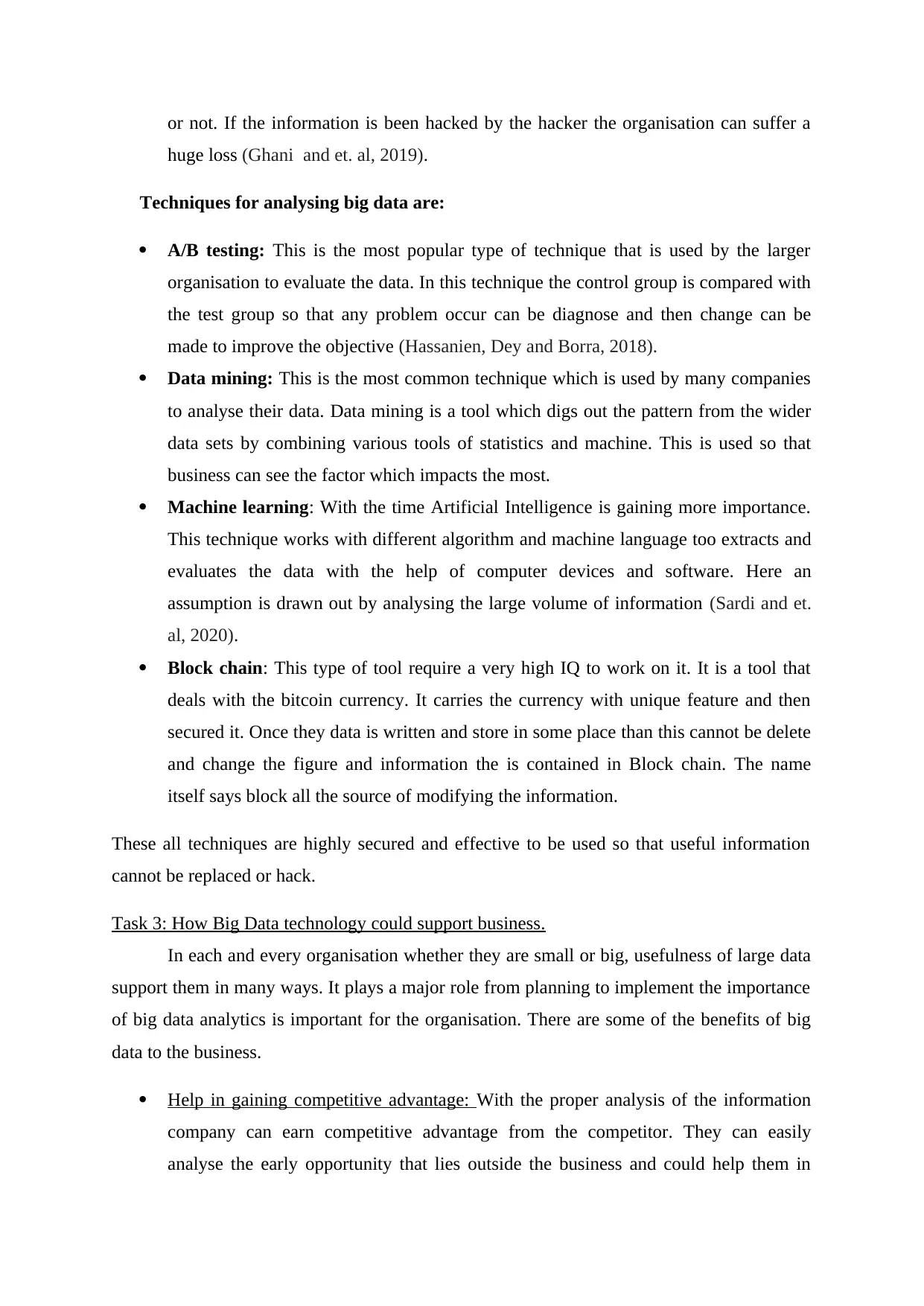
or not. If the information is been hacked by the hacker the organisation can suffer a
huge loss (Ghani and et. al, 2019).
Techniques for analysing big data are:
A/B testing: This is the most popular type of technique that is used by the larger
organisation to evaluate the data. In this technique the control group is compared with
the test group so that any problem occur can be diagnose and then change can be
made to improve the objective (Hassanien, Dey and Borra, 2018).
Data mining: This is the most common technique which is used by many companies
to analyse their data. Data mining is a tool which digs out the pattern from the wider
data sets by combining various tools of statistics and machine. This is used so that
business can see the factor which impacts the most.
Machine learning: With the time Artificial Intelligence is gaining more importance.
This technique works with different algorithm and machine language too extracts and
evaluates the data with the help of computer devices and software. Here an
assumption is drawn out by analysing the large volume of information (Sardi and et.
al, 2020).
Block chain: This type of tool require a very high IQ to work on it. It is a tool that
deals with the bitcoin currency. It carries the currency with unique feature and then
secured it. Once they data is written and store in some place than this cannot be delete
and change the figure and information the is contained in Block chain. The name
itself says block all the source of modifying the information.
These all techniques are highly secured and effective to be used so that useful information
cannot be replaced or hack.
Task 3: How Big Data technology could support business.
In each and every organisation whether they are small or big, usefulness of large data
support them in many ways. It plays a major role from planning to implement the importance
of big data analytics is important for the organisation. There are some of the benefits of big
data to the business.
Help in gaining competitive advantage: With the proper analysis of the information
company can earn competitive advantage from the competitor. They can easily
analyse the early opportunity that lies outside the business and could help them in
huge loss (Ghani and et. al, 2019).
Techniques for analysing big data are:
A/B testing: This is the most popular type of technique that is used by the larger
organisation to evaluate the data. In this technique the control group is compared with
the test group so that any problem occur can be diagnose and then change can be
made to improve the objective (Hassanien, Dey and Borra, 2018).
Data mining: This is the most common technique which is used by many companies
to analyse their data. Data mining is a tool which digs out the pattern from the wider
data sets by combining various tools of statistics and machine. This is used so that
business can see the factor which impacts the most.
Machine learning: With the time Artificial Intelligence is gaining more importance.
This technique works with different algorithm and machine language too extracts and
evaluates the data with the help of computer devices and software. Here an
assumption is drawn out by analysing the large volume of information (Sardi and et.
al, 2020).
Block chain: This type of tool require a very high IQ to work on it. It is a tool that
deals with the bitcoin currency. It carries the currency with unique feature and then
secured it. Once they data is written and store in some place than this cannot be delete
and change the figure and information the is contained in Block chain. The name
itself says block all the source of modifying the information.
These all techniques are highly secured and effective to be used so that useful information
cannot be replaced or hack.
Task 3: How Big Data technology could support business.
In each and every organisation whether they are small or big, usefulness of large data
support them in many ways. It plays a major role from planning to implement the importance
of big data analytics is important for the organisation. There are some of the benefits of big
data to the business.
Help in gaining competitive advantage: With the proper analysis of the information
company can earn competitive advantage from the competitor. They can easily
analyse the early opportunity that lies outside the business and could help them in
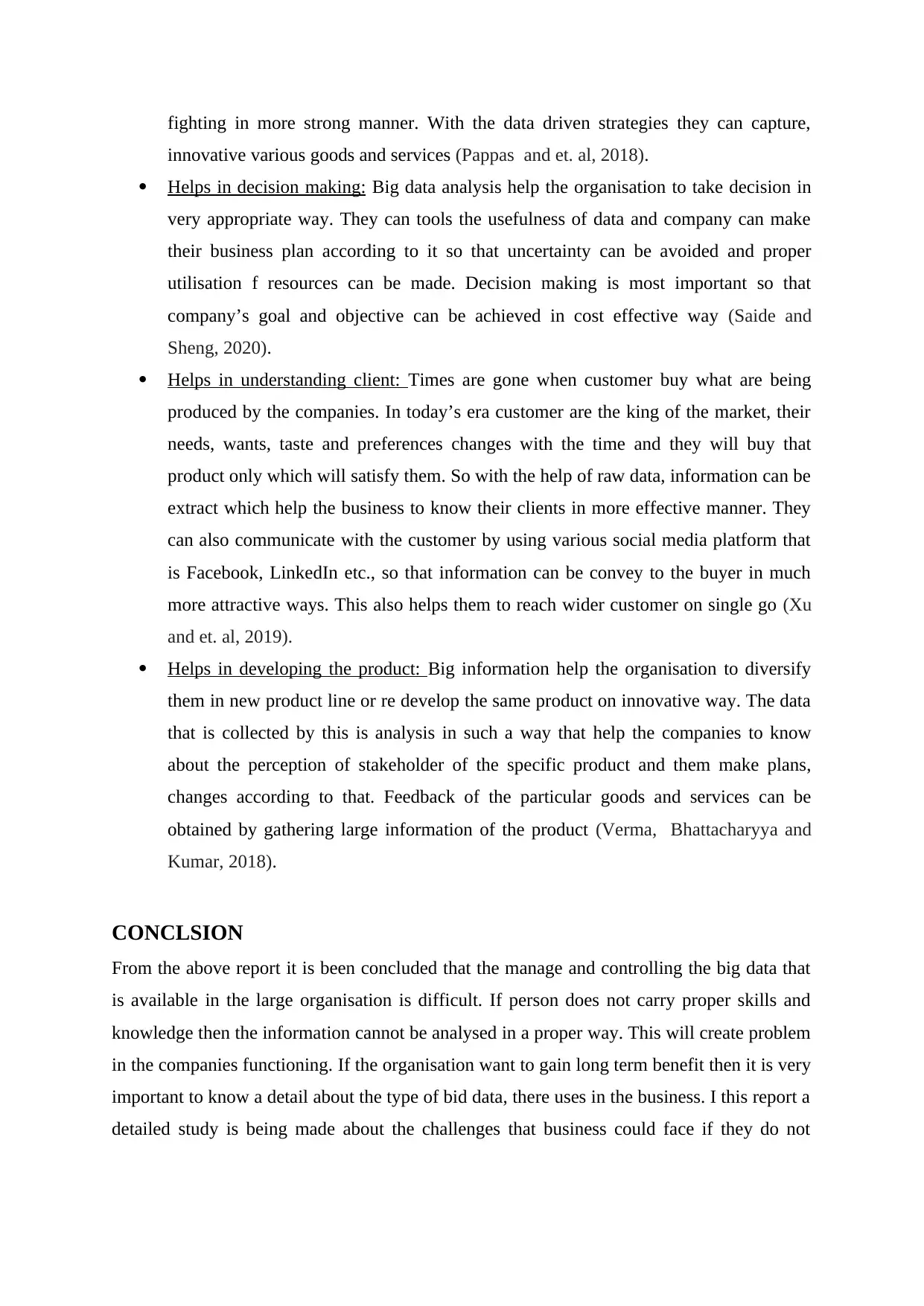
fighting in more strong manner. With the data driven strategies they can capture,
innovative various goods and services (Pappas and et. al, 2018).
Helps in decision making: Big data analysis help the organisation to take decision in
very appropriate way. They can tools the usefulness of data and company can make
their business plan according to it so that uncertainty can be avoided and proper
utilisation f resources can be made. Decision making is most important so that
company’s goal and objective can be achieved in cost effective way (Saide and
Sheng, 2020).
Helps in understanding client: Times are gone when customer buy what are being
produced by the companies. In today’s era customer are the king of the market, their
needs, wants, taste and preferences changes with the time and they will buy that
product only which will satisfy them. So with the help of raw data, information can be
extract which help the business to know their clients in more effective manner. They
can also communicate with the customer by using various social media platform that
is Facebook, LinkedIn etc., so that information can be convey to the buyer in much
more attractive ways. This also helps them to reach wider customer on single go (Xu
and et. al, 2019).
Helps in developing the product: Big information help the organisation to diversify
them in new product line or re develop the same product on innovative way. The data
that is collected by this is analysis in such a way that help the companies to know
about the perception of stakeholder of the specific product and them make plans,
changes according to that. Feedback of the particular goods and services can be
obtained by gathering large information of the product (Verma, Bhattacharyya and
Kumar, 2018).
CONCLSION
From the above report it is been concluded that the manage and controlling the big data that
is available in the large organisation is difficult. If person does not carry proper skills and
knowledge then the information cannot be analysed in a proper way. This will create problem
in the companies functioning. If the organisation want to gain long term benefit then it is very
important to know a detail about the type of bid data, there uses in the business. I this report a
detailed study is being made about the challenges that business could face if they do not
innovative various goods and services (Pappas and et. al, 2018).
Helps in decision making: Big data analysis help the organisation to take decision in
very appropriate way. They can tools the usefulness of data and company can make
their business plan according to it so that uncertainty can be avoided and proper
utilisation f resources can be made. Decision making is most important so that
company’s goal and objective can be achieved in cost effective way (Saide and
Sheng, 2020).
Helps in understanding client: Times are gone when customer buy what are being
produced by the companies. In today’s era customer are the king of the market, their
needs, wants, taste and preferences changes with the time and they will buy that
product only which will satisfy them. So with the help of raw data, information can be
extract which help the business to know their clients in more effective manner. They
can also communicate with the customer by using various social media platform that
is Facebook, LinkedIn etc., so that information can be convey to the buyer in much
more attractive ways. This also helps them to reach wider customer on single go (Xu
and et. al, 2019).
Helps in developing the product: Big information help the organisation to diversify
them in new product line or re develop the same product on innovative way. The data
that is collected by this is analysis in such a way that help the companies to know
about the perception of stakeholder of the specific product and them make plans,
changes according to that. Feedback of the particular goods and services can be
obtained by gathering large information of the product (Verma, Bhattacharyya and
Kumar, 2018).
CONCLSION
From the above report it is been concluded that the manage and controlling the big data that
is available in the large organisation is difficult. If person does not carry proper skills and
knowledge then the information cannot be analysed in a proper way. This will create problem
in the companies functioning. If the organisation want to gain long term benefit then it is very
important to know a detail about the type of bid data, there uses in the business. I this report a
detailed study is being made about the challenges that business could face if they do not
⊘ This is a preview!⊘
Do you want full access?
Subscribe today to unlock all pages.

Trusted by 1+ million students worldwide
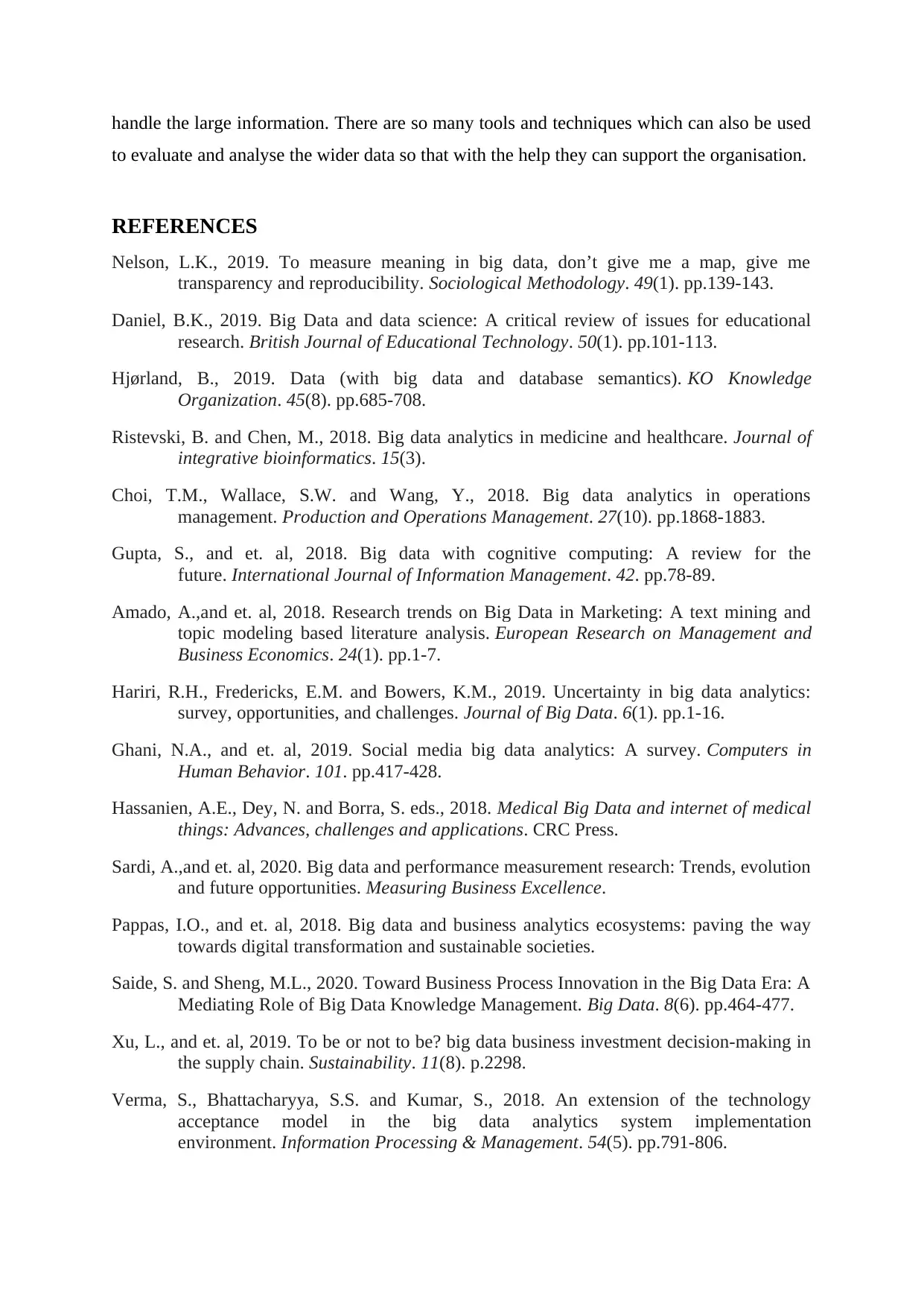
handle the large information. There are so many tools and techniques which can also be used
to evaluate and analyse the wider data so that with the help they can support the organisation.
REFERENCES
Nelson, L.K., 2019. To measure meaning in big data, don’t give me a map, give me
transparency and reproducibility. Sociological Methodology. 49(1). pp.139-143.
Daniel, B.K., 2019. Big Data and data science: A critical review of issues for educational
research. British Journal of Educational Technology. 50(1). pp.101-113.
Hjørland, B., 2019. Data (with big data and database semantics). KO Knowledge
Organization. 45(8). pp.685-708.
Ristevski, B. and Chen, M., 2018. Big data analytics in medicine and healthcare. Journal of
integrative bioinformatics. 15(3).
Choi, T.M., Wallace, S.W. and Wang, Y., 2018. Big data analytics in operations
management. Production and Operations Management. 27(10). pp.1868-1883.
Gupta, S., and et. al, 2018. Big data with cognitive computing: A review for the
future. International Journal of Information Management. 42. pp.78-89.
Amado, A.,and et. al, 2018. Research trends on Big Data in Marketing: A text mining and
topic modeling based literature analysis. European Research on Management and
Business Economics. 24(1). pp.1-7.
Hariri, R.H., Fredericks, E.M. and Bowers, K.M., 2019. Uncertainty in big data analytics:
survey, opportunities, and challenges. Journal of Big Data. 6(1). pp.1-16.
Ghani, N.A., and et. al, 2019. Social media big data analytics: A survey. Computers in
Human Behavior. 101. pp.417-428.
Hassanien, A.E., Dey, N. and Borra, S. eds., 2018. Medical Big Data and internet of medical
things: Advances, challenges and applications. CRC Press.
Sardi, A.,and et. al, 2020. Big data and performance measurement research: Trends, evolution
and future opportunities. Measuring Business Excellence.
Pappas, I.O., and et. al, 2018. Big data and business analytics ecosystems: paving the way
towards digital transformation and sustainable societies.
Saide, S. and Sheng, M.L., 2020. Toward Business Process Innovation in the Big Data Era: A
Mediating Role of Big Data Knowledge Management. Big Data. 8(6). pp.464-477.
Xu, L., and et. al, 2019. To be or not to be? big data business investment decision-making in
the supply chain. Sustainability. 11(8). p.2298.
Verma, S., Bhattacharyya, S.S. and Kumar, S., 2018. An extension of the technology
acceptance model in the big data analytics system implementation
environment. Information Processing & Management. 54(5). pp.791-806.
to evaluate and analyse the wider data so that with the help they can support the organisation.
REFERENCES
Nelson, L.K., 2019. To measure meaning in big data, don’t give me a map, give me
transparency and reproducibility. Sociological Methodology. 49(1). pp.139-143.
Daniel, B.K., 2019. Big Data and data science: A critical review of issues for educational
research. British Journal of Educational Technology. 50(1). pp.101-113.
Hjørland, B., 2019. Data (with big data and database semantics). KO Knowledge
Organization. 45(8). pp.685-708.
Ristevski, B. and Chen, M., 2018. Big data analytics in medicine and healthcare. Journal of
integrative bioinformatics. 15(3).
Choi, T.M., Wallace, S.W. and Wang, Y., 2018. Big data analytics in operations
management. Production and Operations Management. 27(10). pp.1868-1883.
Gupta, S., and et. al, 2018. Big data with cognitive computing: A review for the
future. International Journal of Information Management. 42. pp.78-89.
Amado, A.,and et. al, 2018. Research trends on Big Data in Marketing: A text mining and
topic modeling based literature analysis. European Research on Management and
Business Economics. 24(1). pp.1-7.
Hariri, R.H., Fredericks, E.M. and Bowers, K.M., 2019. Uncertainty in big data analytics:
survey, opportunities, and challenges. Journal of Big Data. 6(1). pp.1-16.
Ghani, N.A., and et. al, 2019. Social media big data analytics: A survey. Computers in
Human Behavior. 101. pp.417-428.
Hassanien, A.E., Dey, N. and Borra, S. eds., 2018. Medical Big Data and internet of medical
things: Advances, challenges and applications. CRC Press.
Sardi, A.,and et. al, 2020. Big data and performance measurement research: Trends, evolution
and future opportunities. Measuring Business Excellence.
Pappas, I.O., and et. al, 2018. Big data and business analytics ecosystems: paving the way
towards digital transformation and sustainable societies.
Saide, S. and Sheng, M.L., 2020. Toward Business Process Innovation in the Big Data Era: A
Mediating Role of Big Data Knowledge Management. Big Data. 8(6). pp.464-477.
Xu, L., and et. al, 2019. To be or not to be? big data business investment decision-making in
the supply chain. Sustainability. 11(8). p.2298.
Verma, S., Bhattacharyya, S.S. and Kumar, S., 2018. An extension of the technology
acceptance model in the big data analytics system implementation
environment. Information Processing & Management. 54(5). pp.791-806.
Paraphrase This Document
Need a fresh take? Get an instant paraphrase of this document with our AI Paraphraser

1 out of 8
Related Documents
Your All-in-One AI-Powered Toolkit for Academic Success.
+13062052269
info@desklib.com
Available 24*7 on WhatsApp / Email
![[object Object]](/_next/static/media/star-bottom.7253800d.svg)
Unlock your academic potential
Copyright © 2020–2025 A2Z Services. All Rights Reserved. Developed and managed by ZUCOL.

